Rapport

Executive summary
The era of “New Retail” that Alibaba founder Jack Ma envisioned is starting to emerge across China in ways that promise big gains for consumer products companies that act decisively and systematically while causing others to lag behind. In 2016, Ma predicted a seamless merger of offline, online and logistics for a dynamic new world of retailing. His vision now can be seen in the millions of mom-and-pop stores throughout China that are taking on new life as order-and-delivery stations for e-commerce. It is there in the booming food delivery platforms such as Hema, which fulfills more than half of its orders online. And you can glimpse it in China’s ubiquitous mobile payments. Chinese consumers use their phones for 60 times more mobile payments than consumers in the US do.
Enabled by leading-edge technology, New Retail has created an imperative for brands. Alibaba CEO Daniel Zhang summed up the unfolding challenge in a letter to investors when he said companies must use Big Data analytics to redefine the traditional core elements of retailing—consumers, merchandise and stores—and the relationship among those elements to upgrade current formats and create new retail occasions.
Indeed, China’s e-commerce platform, represented by Tmall, is evolving to establish a New Retail infrastructure, empowering brands with data. Leading brands are gaining an edge by using the emergence of New Retail as an occasion to build a new consumer-centric model while at the same time creating operations that are more efficient. Brands as diverse as Mondelez, Friso, Estée Lauder and Bestseller are leading the charge to shape tomorrow’s retailing. Consider how pioneers are reimagining those core elements and the relationships among them.
For starters, people are no longer viewed only as consumers. The most forward-thinking brands also see them in the role of coproducers. In the past, with relatively limited consumer insights, it was sufficient for a brand to identify target consumers and determine their needs. Now, armed with a comprehensive—and dynamic—profile, brands have new missions, such as finding ways to stimulate consumer needs, identifying look-alike consumers and turning consumers into brand ambassadors who effectively cocreate the brand.
Also, products are advancing from commodities to become part of the consumption process and an integrated consumer experience. As the old business-to-consumer model evolves from the simple goal of meeting mass demand to a world of consumer-data-inspired personalized products and delivery, the best brands are determining how to integrate products into the overall customer experience—which includes not only shopping but learning about a product, using it and recommending it.
In addition, stores have extended from online-only or offline-only into a seamless omnichannel consumer experience that’s fully integrated. People can shop while enjoying content or while spending time on social networks, for example, as well as in stores or on e-commerce platforms. Brands are creating occasions beyond the constraints of time and location.
Winning brands are taking six steps to reshape the future and make the most of New Retail.
Step 1: Identify new governance principles for a customer-centric model
The best brands put customers at the heart of their operations, with full consideration of the end-to-end customer experience, from awareness to purchase to referral. In addition, they commit to embedding data and smart technology into their operations, breaking down the data silos within their organizations for cross-function interconnection and extending their links with the broader ecosystem.
Step 2: Develop new flexibility and efficiency in R&D and supply chains
We see the best companies transforming their operations to take advantage of retailing’s new realities, and making those operations more efficient in the process. These brands use real, comprehensive and timely understanding of consumers to optimize R&D and their supply chains. In R&D, they adapt to shorter cycles while engaging with consumers directly in the product development process—early and often. These brands make supply chains flexible enough to adjust to real-time frontline sales results and the more accurate estimates enabled by artificial intelligence, the Internet of Things, blockchain and other emerging technologies. Companies selling in China are at the forefront of this movement to use smart technology.
Step 3: Reimagine marketing and consumer management for New Retail
The digital ecosystem that encompasses purchase, payment, delivery and all the other customer touchpoints provides the opportunity to reach consumers whenever and wherever they are online. Online becomes a closed loop for interacting with consumers, collecting data, and gaining the insights that can help brands develop and deliver personalized marketing messages at the appropriate customer touchpoints, constantly refining what they learn and how they market. It is a shift in philosophy that turns marketing from a brand expense into a brand asset.
Step 4: Modernize route-to-market and retail formats
In “Old Retail,” the multilayered distribution network contains many pain points. The costs are high, and brands have limited control or transparency into sales. Now, leading brands are replacing those old networks with streamlined electronic route-to-market models that help them reduce costs with fewer levels, expand their coverage, and gain visibility into real-time inventory and sales data while improving point-of-sale and channel relationships. The distribution changes also are enabling brands to introduce targeted retail formats that reduce communication costs while increasing SKU productivity. They can tailor messaging for similar stores and rely on consumer insights generated from sales data to optimize the product portfolio within a retail outlet. A new major role for the store: collecting consumer data.
Step 5: Transform the organization and operating model for digital
These operational changes won’t yield sufficient results without redesigning the organization to make full use of New Retail’s power. Winners understand the need to organize for data. For example, the organizational structure needs to allow for seamless coordination among functions and between offline and online platforms. Success in the digital age requires cross-functional work on marketing, sales, consumer engagement and data analysis. Another important consideration: coordinating resources across different brands.
Step 6: Invest in new technology development
New technologies give brands the opportunity to boost their operational efficiency as they deliver a better customer experience. However, companies need to take a systematic approach to choosing from the evolving options for improving decisions and connecting business operations. As a first giant step to move out ahead of rivals in this new world of retailing, brands should assess their current digitalization status (their “point of departure”), set clear goals for their digital transformation (“point of arrival”) and spell out a clear roadmap and implementation plan.
As New Retail takes root, the brands that thrive will acknowledge that the changes they make today—the new capabilities they develop and the operating models they devise—won’t necessarily help them a year from now. New Retail is a work in progress, requiring brands to constantly refine and reinvent themselves for new occasions, new formats and the steady flow of new ideas that will define retailing tomorrow.
Introducing New Retail
It feels like a decade since Alibaba founder Jack Ma introduced the term “New Retail” to describe a future in which online, offline and logistics would merge to create a dynamic new retailing era.
The reality is that he coined the name recently, in 2016. The changes he predicted are arriving so swiftly and so dramatically that each month seems to bring a big new preview of what retailing will look like everywhere, as China sets the pace for the rest of the world. Indeed, with millions of mom-and-pop stores now taking on new life as order-and-delivery stations for e-commerce, with food delivery platforms such as Hema fulfilling more than half of its orders online, and with mobile payments rising to more than 60 times the US level, wherever retailing is headed, China is already there (see Figure 1).

For brands hoping to sell in China, survival means moving equally fast to capture this future ahead of competitors, both incumbents and digitally savvy upstarts. It will not be enough merely to keep up. Brands will be required to get ahead and help shape the vast changes, even as they completely overhaul the rules of engagement. In a letter to investors, Alibaba CEO Daniel Zhang summed up the challenge when he called for using Big Data analytics to redefine the traditional core elements of retailing—consumers, merchandise and stores—and the relationship among those elements to upgrade current formats and create new retail occasions.
China’s e-commerce platform, represented by Tmall, is evolving to establish New Retail infrastructure, empowering brands with data. Leading brands are gaining an edge by using the emergence of New Retail as an occasion to build a new consumer-centric model while at the same time creating operations that are more efficient.
Consider the fundamental changes and ways that the best brands are responding (see Figure 2).

Consumers. People are no longer viewed only as consumers. The most forward-thinking brands also see them in the role of coproducers. In the past, with relatively limited consumer insights, it was sufficient for a brand to identify target consumers and determine their needs. Now, armed with a comprehensive—and dynamic—profile, brands have new missions, such as finding ways to stimulate consumer needs, identifying look-alike consumers and turning consumers into brand ambassadors who effectively cocreate the brand. Welcome to the C2B (consumer-to-business) age.
Merchandise. Products are advancing from commodities to become part of the consumption process and an integrated consumer experience. As the old business-to-consumer model evolves from the simple goal of meeting mass demand to a world of consumer-data-inspired personalized products and delivery, the best brands are determining how to integrate products into the overall customer experience: not only shopping but also learning about a product, using it, talking about it on social media and recommending it.
Stores. Stores have extended from online-only or offline-only into a seamless omnichannel consumer experience that’s fully integrated. People can shop while enjoying content or while spending time on social networks, for example, as well as in stores or on e-commerce platforms. Creating occasions beyond the constraints of time and location is among the new moves that winning brands are making to get ahead.
How should brands change to fully capitalize on New Retail?
From our experience, some brands are in a stronger competitive position to win in New Retail. These companies take a systematic approach that covers six well-defined steps.
Step 1: Identify new governance principles for a customer-centric model
The best brands redefine the relationship among consumers, merchandise and stores in a way that makes the most of their operations while strengthening such fundamentals as the operating model and ability to develop new technology (see Figures 3 and 4). This starts by acknowledging—and acting on—two principles of New Retail. They put customers at the heart of operations, with full consideration of the end-to-end customer experience, from awareness to purchase to referral. In addition, they commit to embedding data and smart technology into their operations, breaking down the data silos within their organizations for cross-function interconnection and extending their links with the broader ecosystem. In the past, they may have used internal CRM data to inform functional business decisions in such areas as R&D and production, marketing and sales. Now they continually refine the data and expand their data sources through external partnerships, engaging in test-and-learn exercises to develop and act on broader, deeper and constantly changing consumer insights. They establish a two-way closed loop to connect internal and external data for smarter business decisions.

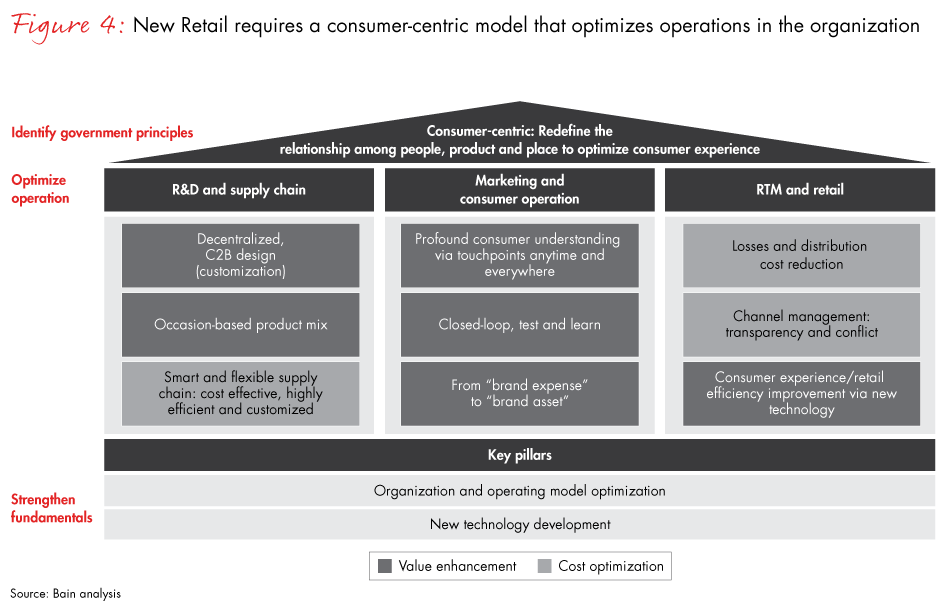
Step 2: Develop new flexibility and efficiency in R&D and supply chains
New Retail is having a big effect on every corner of a brand’s operations. As consumer needs become more diversified, the potential consumer pool would shrink if existing R&D and supply chain strategies remain unchanged. We see the best companies transforming those operations to take advantage of retailing’s new realities, and making them more efficient in the process. These brands use real, comprehensive and timely understanding of consumers to optimize R&D and their supply chains (see Figures 5 and 6). For example, as they deliver personalized products and services, they thoughtfully adapt to shorter R&D cycles. Pioneering companies also take an interactive approach to R&D that allows for timely changes in design and planning based on real-time consumer behavior. Importantly, they view their consumers as participants in the R&D process, engaging with them early in product development, conducting consumer testing before production and connecting frequently before a product launch to enhance loyalty.


A brand’s customization model demands different levels of complexity in its R&D capability and supply chain. For example, it is possible to create a product mix that requires virtually no change in an existing supply chain. That would be the case when allowing customers to select slightly different shoe sizes for their left and right feet, or when offering personalized wine labels for birthdays or weddings. However, the supply chain becomes more complex when a company integrates consumer ideas into production—enabling them to personalize the colors of outer packaging, for example. The highest degree of complexity happens when companies manufacture a product based on consumer needs, relying on consumer participation throughout the process, from ideation and R&D to marketing and sales.
To see customization in action, look no further than the whimsical Oreo Music Box, which Mondelez introduced on Tmall’s Super Brand Day 2017, with the goal of making Oreos more popular among teenagers, strengthening the brand’s emotional appeal to consumers of all ages and driving traffic to its Tmall store. The company created a truly inventive product: a turntable-like device that plays tunes when an Oreo biscuit is placed on it. Customers can change the prerecorded music simply by taking a bite from the Oreo and placing it back on the music box. They can also record their own voices and decorate the device, customizing it by scanning the QR code. The music box is a good illustration of what it now takes to get ahead in New Retail. The company partnered with third-party vendors and Tmall in its development and marketing. In addition, by relying on a flexible supply chain, Mondelez was able to get the product to market in a record seven days, as opposed to the traditional two to three months. A New Retail success story, the “singing biscuits” generated 80 times more sales on Mondelez’s site than average, with 90% of the purchases made by new consumers.
Brands are making supply chains flexible enough to adjust to real-time frontline sales results and the more accurate estimates enabled by artificial intelligence (AI), the Internet of Things (IoT), blockchain and other emerging technologies. Companies selling in China are at the forefront of this movement to use smart technology. The most advanced among them integrate all the parties in the supply chain, analyzing the full spectrum of available data to improve visualization, analysis and supply chain automation (see Figure 7). For example, a visualized real-time supply chain enables these companies to track cargo and machine information to quickly detect and solve problems. They rely on robots in factories. They develop smart analytics to streamline inventory forecasting and planning, as well as category selection, procurement, reallocation and replenishment. These companies make the required investments to choose the right service providers, manage the data and improve the operating efficiency of their supply chains.
Nestlé has reaped significant benefits from its “One Set Inventory” unified supply chain, which serves different channels (business-to-business, business-to-consumer, offline-to-online and others), sharing its logistics service and inventory (see Figure 8). From a single hub, Nestlé ships to different channels instantly, choosing the destination based on insights generated by real-time data. The move has dramatically improved turnover efficiency; the online product shortage rate has dropped from 22% to 5%. It has also lowered logistics costs, reducing cross-region delivery from 60% to 10%. In addition, the new supply chain setup has improved delivery timeliness for Nestlé. Now, nearly 80% of orders are delivered same day or next day.


Step 3: Reimagine marketing and consumer management for New Retail
New Retail changes the game in marketing and consumer management, too. The digital ecosystem that encompasses purchase, payment, delivery and all the other customer touchpoints provides the opportunity to reach consumers whenever and wherever they are online. That is why winning brands have extended the horizons for digital marketing. For them, online is not limited to a sales channel; rather, it becomes a consumer-centric closed loop for unlocking business potential (see Figure 9). These companies collect data whenever a consumer uses an app to hail a taxi or process a payment. They integrate online and offline data, incorporating everything from the categories customers browse online to their responses to digital marketing to the frequency of visits to physical stores and the amounts they typically spend there. From this composite of transactions, brands gain insights that help them develop and deliver personalized marketing messages at the appropriate customer touchpoints, constantly refining what they learn and how they market. It is a major shift in philosophy that turns marketing from a brand expense into a brand asset.

Milk and infant formula producer Friso created an online closed loop to cover the stage gates of the consumer journey. The first stage involves identifying target consumers and customizing marketing information based on such elements as an individual’s stage of pregnancy or purchasing power. Friso then expands its marketing efforts to include multiple touchpoints such as popular social media platform Weibo and video websites to maximize brand exposure and accumulate consumer behavioral data. Finally, the brand continuously interacts with consumers via content marketing through its online membership platform, which enhances loyalty and provides more data for further marketing efforts.
Cosmetics brand Estée Lauder takes a similar approach, continuously building, refining and drawing from its consumer database (see Figure 10). To enhance awareness, the brand recently initiated a campaign in which it blended ads with content to reach targeted potential consumers in multiple channels. Its precise consumer profiling enabled it to connect with more than 10 million targeted consumers in six days and attract more than 100,000 new followers. It then interacted with those consumers through diversified media, using each interaction as an opportunity to trace consumer behavior. (Traditionally, companies only track click-through rates without generating further insights.) This effort enabled Estée Lauder to reach more than 500,000 fans in a two-week period. About 12% of those consumers interacted with the brand and revisited the site to research or browse products. It then relied on Big Data to zero in on more than a million high-value, easy-to-convert consumers in its database and targeted them for resell. The effort boosted Estée Lauder’s conversion rate by 80% over previous approaches.

Step 4: Modernize route-to-market and retail formats
Distribution and retail formats are being reinvented with New Retail.
Let’s begin with distribution. Under the old and painful multilayered network, stores—especially traditional trade—had limited control and transparency; there was a lack of meaningful data, and the costs of distribution were high for limited channel penetration. Consider the traditional distribution path: A brand sells to multiple levels of wholesalers and distributors at the province, city and county level, which in turn supply local mom-and-pop stores. In addition to the many handoffs required, the markups at each stage and the lack of transparency on consumer behavior, any single distributor may have offered only limited SKUs (and mostly local brands) to these small stores. In recent years, this antiquated system started feeling the strains of China’s decelerating growth, with many distributors exiting the business.
Now, leading brands are replacing those old networks with streamlined electronic route-to-market (e-RTM) models that help them reduce costs with fewer levels, expand their coverage, and gain visibility into real-time inventory and sales data while improving point-of-sale and channel relationships (see Figure 11). Offering instant access to point-of-sale data at mom-and-pop stores, these new digital platforms help both brands and retailers. Brands are able to make quick and better-informed decisions based on channel sales activity and consumer needs. These systems also arm them with the data needed to provide value-added services to each outlet. Retailers receive a product mix tailored to the actual sales activity in their stores. Brands have learned a key lesson as they build and adapt to these new digital route-to-market approaches: It is critical to hone brand strategies to gain the most from e-RTM and to select business partners thoughtfully, based on the unique characteristics of their product categories.
We see three different approaches to e-RTM based on a brand’s relationship with traditional distributors (see Figure 12). The most collaborative model involves using the e-RTM system for placing orders but working with existing distributors for inventory control, warehouse management and delivery. In this model, retailers rely on either the existing distributors or brands for in-store execution. A second model requires collaborating with existing distributors but controlling inventory and delivery. A third, more disruptive, model relies on e-RTM for the entire process—spanning order placement, inventory control, warehouse management and delivery—but works with existing distributors or brands for in-store execution.

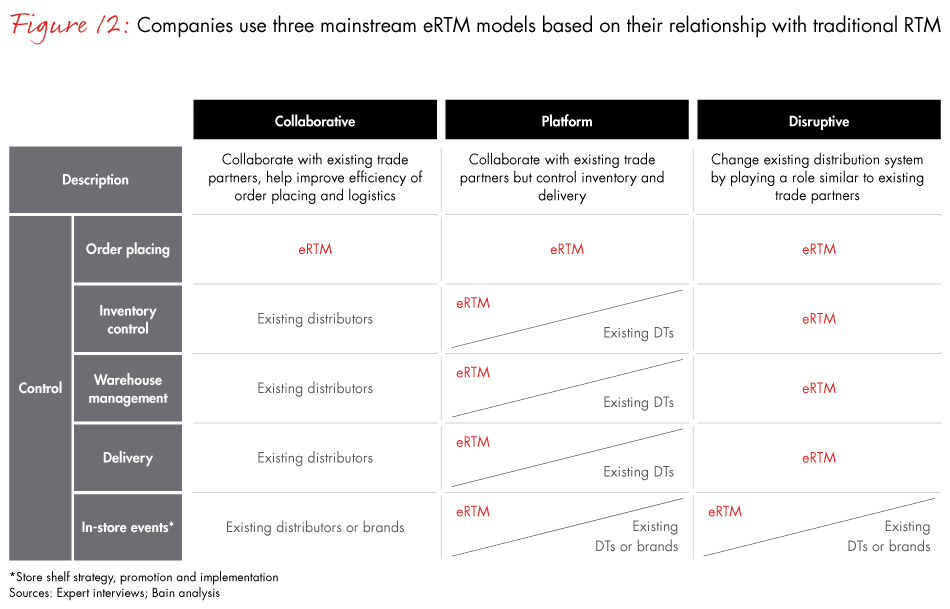
Bestseller Fashion Group, which operates 8,000 stores in more than 500 Chinese cities, has used its new distribution platform to create a seamless omnichannel experience for consumers (see Figure 13). The company combines its online and offline loyalty programs to build an in-depth customer profile, merging information from a consumer’s activity on social networks, Taobao, Tmall, its own website and other sites with data generated from the consumer’s visits to physical stores. It uses data from the more than 30 million customer loyalty members to build customized consumer operations and then engages consumers with differentiated content based on their unique behavior. This approach has helped the company synchronize inventory between its online and offline channels and spur activities that have streamlined logistics costs, such as order online and pick up in store. These moves have helped Bestseller reduce its average delivery time from three days to one-and-a-half days.
These distribution changes are enabling leading brands to introduce retail formats that reduce communication costs while increasing SKU productivity. Consumer data allows them to create more targeted retail outlets for specific consumer segments, which helps brands optimize their communication costs by relying on tailored messaging for similar stores. These brands also rely on the consumer insights generated from newly available data to optimize the product portfolio within a retail outlet. The stores become centers for collecting consumer data. Brands analyze the data to understand consumer behavior, identify select high-potential SKUs and generate consumer insights to support brand communication.
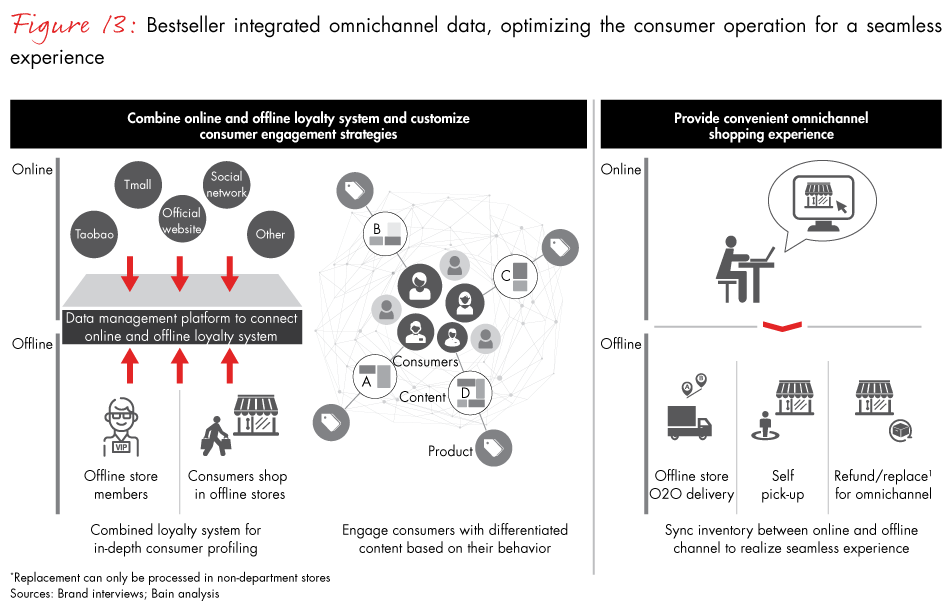
Step 5: Transform the organization and operating model for digital
Building a framework and operations around customers and data is critical for brands hoping to master New Retail. However, those big moves will not yield sufficient results without redesigning the organization to make full use of New Retail’s power. Many brands entered the era of New Retail not only with limited capabilities for acquiring and analyzing data, but also with organizational structures and operating models that make it difficult to share and act on insights gained from that data. Winners understand the need to focus on organizing for data.
Among the most important considerations: The organizational structure must allow for seamless coordination among functions, which is something that traditional organizations rarely accommodate. Consider that many current models use different key performance indicators for marketing and e-commerce, and that reporting lines do not support the cross-function work on marketing, sales, consumer engagement and data analysis. There is often insufficient coordination between offline channels and e-commerce platforms, resulting in potential tradeoffs and conflicts. In addition, there’s often little attention paid to coordinating resources across different brands.
As companies adapt their organizations to the changing needs of New Retail, it is critical that the organizational design reflect the company’s stage in its digital transformation (see Figure 14). For example, in a company’s early days—when digital’s major role is that of a new sales channel—the digital team will be most effective if it operates within the sales unit. If digital is primarily used for marketing and consumer engagement, the digital team can operate within the marketing department. Alternatively, if the company is slightly more advanced in its digital transformation, that team can operate independently, with dotted-line reporting to both sales and marketing. This structure provides such benefits as the synergies created by combining digital and traditional advertising. However, for companies much further along, digital should be a standalone business unit that integrates resources across all functions, with a decentralized and Agile operating model that fosters fast decisions. In all situations, all functions should be closely connected to consumers, constantly gathering their input and the information that serves as the lifeblood of New Retail.

While the ultimate goal is to be able to move quickly, brands need to recognize that developing enterprise-wide agility does not happen overnight. A multistage journey typically takes two to three years to complete (see Figure 15). The path begins by setting up technology, tools and other elements of a supporting infrastructure and empowering a few Agile teams in selected areas. The next stage involves expanding those teams in waves to establish Agile operations in complete business units or functions.
All Agile teams operate according to the same manifesto: Teams are cross-functional and empowered, activities are time-boxed around specific outcomes, work is iterative and incremental, and problems are solved in a modular and adaptive manner. Digital requires many new or upgraded capabilities, so it is critical that brands clearly define responsibilities (see Figure 16).
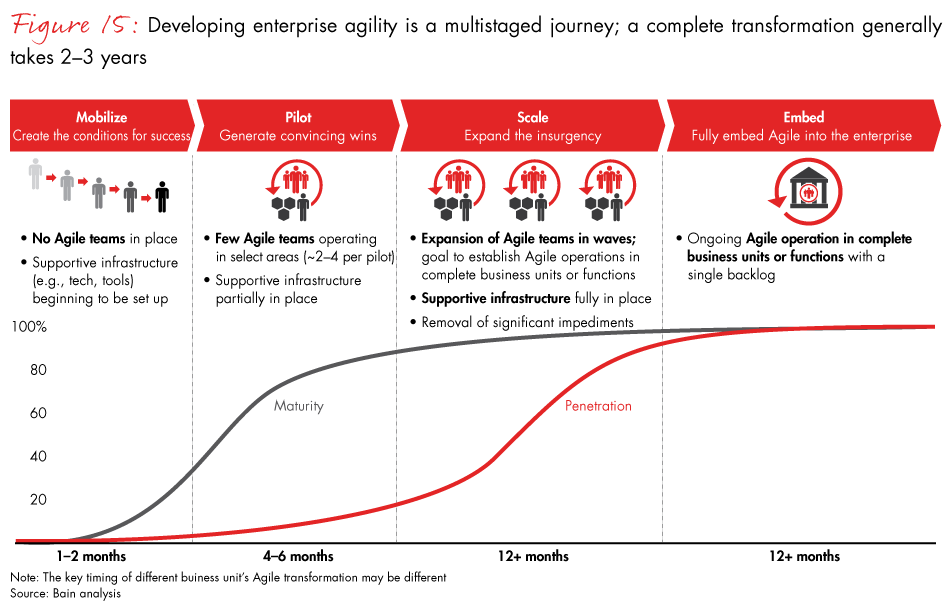

Step 6: Invest in new technology development
New technologies give brands the opportunity to boost their operational efficiency as they deliver a better customer experience (see Figure 17). Today and tomorrow, companies face many challenges as they develop a game plan for new technology, choosing from the evolving options for improving decisions and connecting business operations. For example, a brand laying plans to upgrade its R&D and supply chain capabilities can look to AI for more accurate demand, production and supply forecasting. It could rely on the IoT to identify and track the real-time status of cargo or remotely manage equipment. It could deploy augmented reality or virtual reality to conduct sample testing with consumers to upgrade products based on real-time feedback. It could use robots to perform manual factory tasks, or pioneer the use of drones for delivery and pickup. It could use 3-D or 4-D printing to customize products for consumer needs.
Similarly, brands must consider the best approach for adopting a single technology across multiple functions to deliver the most extensive benefits. For example, they can employ AI to obtain forecasts that are more accurate, assist in after-sales service, collect consumer feedback and plan optimal product distribution. As a first giant step to move out ahead of rivals in this new world of retailing, brands need to assess their current digitalization status (their “point of departure”), set clear goals for their digital transformation (their “point of arrival”), and spell out a clear implementation plan and roadmap (see Figure 18).
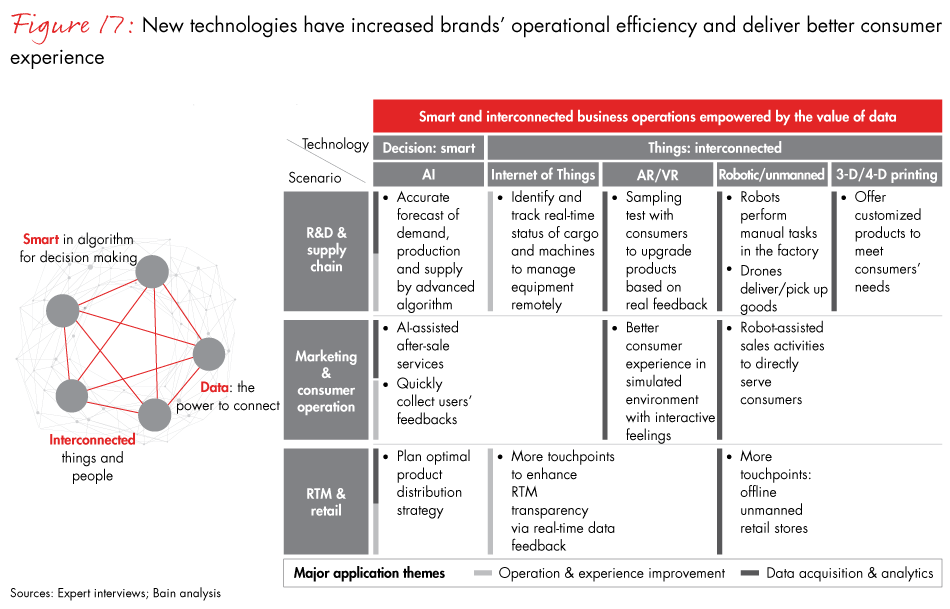

As New Retail takes root, the brands that thrive will acknowledge that the changes they make today—the new capabilities they develop and the operating models they devise—won’t necessarily help them a year from now. New Retail is a work in progress, requiring brands to constantly refine and reinvent themselves for new occasions, new formats and the steady flow of new ideas that will define retailing tomorrow.
About the authors and acknowledgments
Jason Ding is a partner with Bain & Company’s Beijing office. Bruno Lannes is a partner with Bain’s Shanghai office. Larry Zhu is a partner with Bain’s Hong Kong office. Hongbing Gao: Vice President of Alibaba Group, Director of AliResearch. Liqi Peng: Vice President of Alibaba Group, President of UniOperation Unit. Fei Song: Vice Director of AliResearch, Senior Adviser. Zhengwei Jiang: Senior Algorithm Expert of AliResearch.
The report is a joint effort between Bain & Company and AliResearch. The authors would like to extend gratitude to all who contributed to this report, including Lily Shao, Evan Chen and Yinzhen Wang from Bain & Company; and Chris Tung, Jie Jing, Kevin Lin, Max Zhang, Qiao Yan, David Ye, Kurt Li, Jian Yang, Tim Zheng, Will Zhou, Rick Zeng, Mina Zhang, Lili Wang, Eric Wang, Peter Zhang, Menglin Xu, Anny Liu, Sherry Lang, Stella Wang, Robert Huo, Sharon Yan, Zhao Yan, Kenny Wang, Wenqian Hua, Camir Wang, Eva Rao, Fred Wu, Simon Tu, Hai Yang, Zhen Zeng, Meaning Guo, MuHua Zhang, Lily Shen, Jim Cao, Fudong Han, Jason Jiang, Yonghua Pan, Joanna Lyu, Heaven Han, William Cheng and Sandy Xie from Ali Group.
About AliResearch
Established in 2007, AliResearch (Alibaba Research Institute) is harnessing the scale and scope of the world’s largest and most vibrant digital business ecosystem, consisting of e-commerce, logistics, cloud computing, big data and entertainment. Adhering to the spirit of openness and sharing of the Internet, we have become a think tank platform dedicated to new business, new economy and new governance through sharing of data, technology, cases and ideas for researchers and think tanks. AliResearch covers microlevel research such as consumer insights, digital transformation and business model innovation (C2B, future business organization), midlevel research on industry digitization such as supply chain, e-commerce logistics and rural e-commerce, macrolevel research on dynamics between new and old economy such as Internet and employment, consumption and globalization, Internet governance research such as network regulation and e-commerce legislation, and future research such as information economics.
Results Delivery® is a registered trademark of Bain & Company, Inc.

















